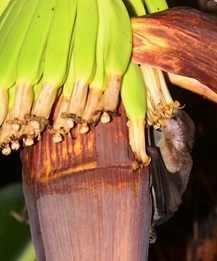
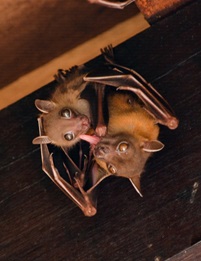
Cave Nectar Bat pollinating a banana flower when feeding (left) and Lesser Dog-faced Bat with young roosting on wood trellis (right)
Bats in Singapore
Did you know that Singapore has native bats not only in our forests, but also in our parks, gardens and urban areas? Fruit bats are important pollinators for edible plants like durians, papaya and petai, and insectivorous bats are key predators of insects and help keep their population in check. While some people may be afraid of bats, it is important to note that they are generally harmless and are a crucial part of both our urban and natural landscape.
You may be asking: What are the benefits or risks of bats in Singapore? What should you do if you find bats in your house? Is it true that bats can pass viruses to humans?
Read on to find out more or download the bat advisory here!
What are bats?
Bats are the world's only flying mammals and are among the most species diverse among all mammals. They are hardly seen in the day as they are nocturnal, which means they are active at night. Bats have diverse diets and they can be nectivorous (nectar-eating), frugivorous (fruit-eating) or insectivorous (insect-eating). Hence, they play an important role in the ecosystem by pollinating flowers, dispersing seeds, and controlling insect populations.
Singapore has about 25 species of bats, out of more than 1000 bat species in the world! These bats are all native to our tropical island. The most commonly seen bats are the Lesser Dog-faced Fruit Bat (Cynopterus brachyotis), the Javan pipistrelle (Pipistrellus javanicus), the Lesser Asiatic Yellow Bat (Scotophilus kuhlii), the Cave Nectar Bat (Eonycteris spelaea), and the Whiskered Myotis (Myotis muricola). We also have some interesting bats such as the Greater False Vampire Bat (Megaderma lyra) (which are not actual vampires!), Lesser Bamboo Bat (Tyloncteris pachypus) and Horseshoe Bats (Rhinolophus sp.).
Our native bats help to pollinate the flowers of some of our important food crops and favourite food - durians, bananas and petai beans. The bats also sustain and regenerate our precious rainforests by pollinating flowers and dispersing their seeds so that new plants can grow. Insectivorous bats feed on many kinds of insects, and help to keep their population in check.

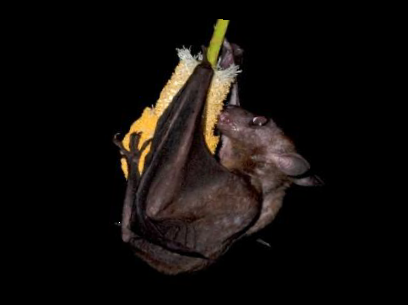
Cave Nectar Bat pollinating a banana flower (left) and petai flower (right)
Generally, bats can be found across our island, wherever there is food and suitable roosting spots. Some bats have adapted to our urban spaces and can be seen flying through our streets from dusk till dawn. Keep an eye out around open canals in the evening if you’d like to spot a bat in your neighbourhood. Bats will fly by to take a drink from canals right after they wake up!
Important things to note
If you come across bats that are injured, distressed or trapped, call our Animal Response Centre at 1800-476-1600 and we will send professionals who are trained in handling and caring for wildlife to assist you. Please avoid handling the bat yourself as this may cause further stress or injury to the animal. The bat may also bite in self-defence.
Please refrain from putting food out to feed bats. Bats have sufficient naturally occurring food that is healthier for them than processed human food. They play an important role as pollinators and seed dispersers of plants in our green spaces. Feeding of bats will lead to them becoming dependent on humans for survival, as well as affect the regeneration of our rainforests. Feeding of all wildlife in Singapore is also prohibited under the Wildlife Act.
There are ways to deter bats from entering your premises and being in close contact with people. However, bats should be left alone if they are seen in a garden or outdoors, and if they are not causing any inconvenience. They are a part of the ecosystem and will come and go on their own. By understanding the important ecological role that bats play, we can live harmoniously with the wildlife found in our City in Nature
Bats in our living environment
Most people are not aware that they share their neighbourhood with bats, as the mammals spend a lot of time flying around looking for food. Insectivorous bats will hunt for insects attracted to light from lamp posts, and fruit bats will forage for fruit from a variety of shrubs and trees. Bats do swoop close to the ground in flight and may come close to people, but do not be alarmed and move away if you feel uncomfortable. Bats do not attack people. If you encounter them flying around, they are probably swooping towards insects or fruits on the trees near you and mean you no harm!
Flying or roosting in gardens: As bats are naturally occurring and move long distances to search for food, it would not be feasible to remove the bats from an estate. The best way forward would be to minimise the disturbances they may cause. Bats are attracted to the scent of fruit or flowers. If you notice that there are trees in your premises that the bats are attracted to, you may wish to harvest the fruits or cover them with cloth or mesh bags.
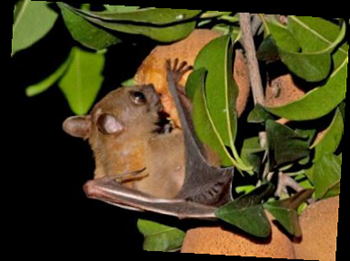
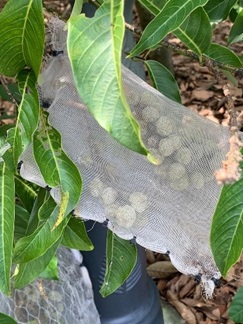
Fruit bat eating chiku fruit (left) and cloth mesh used to wrap fruits to prevent predation by animals (right)
There may be rare occasions when bats enter your premises. Here’s what to do when this occurs:
Accidental entry: Bats may sometimes fly into buildings by accident. To help a bat find its way out, open the windows as wide as possible and turn off all the lights and spinning fans. Close doors leading deeper into the building and remove pets such as cats or dogs from the area. Should the bat decide to seek shelter in your house by hiding in your curtains or under your bed and does not escape on its own, call the NParks Animal Response Centre at 1800-476-1600. Do not attempt to handle the bat by yourself as it may bite in fear or defence. Improper handling can also injure it.
Frequent entry to eat fruits in the house: Fruit bats are attracted to the scent of fruit. In the event that a bat has found and eaten fruit in your house, it is possible that it may return for a second visit or associate other houses with food. To discourage the bat from coming back, keep fruits out of its reach. A simple way to do so is by placing the fruits in covered baskets. If the bat persists, you could place a temporary mesh on the windows to prevent its entry in the evenings, until it stops returning. Mesh can be found at most hardware stores.
Roosting on the ceiling: On very rare occasions, bats may roost on building structures, which could cause some inconvenience as they may leave guano (droppings) in the vicinity. The most effective way to discourage bats from roosting is to block their access to these roosting spots. This could mean sealing up the gaps between roof tiles through which they enter, or covering up the structures that they cling onto with a smooth acrylic or plastic sheet. This would make it difficult for them to enter or roost. Other deterrents include placing mothballs or reflective objects at the roosting spot, or applying lubricant to the grip surface. Illuminating roosting sites may not be very effective, and may even attract insect bats.
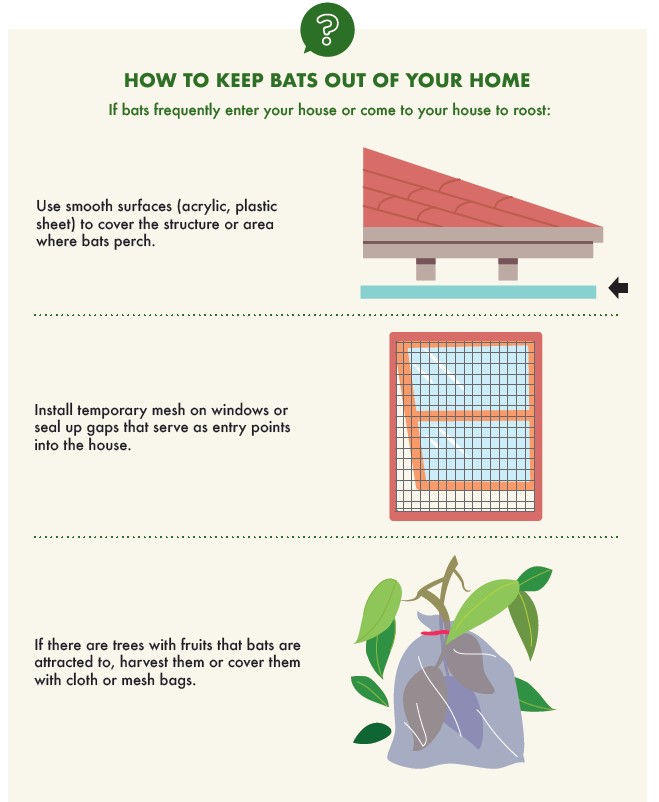
Do bats pose health risks to humans?
You may have read or heard about articles suggesting that bats are a source of zoonotic viruses that can be spread to people. NParks has been studying Singapore’s bat populations since 2011. To date, our biosurveillance programmes have not detected any transmittable zoonotic diseases, including COVID-19, in our bats. There have been no cases of sicknesses transmitted from bats to humans in Singapore. NParks will continue to closely monitor the local bat population.
See the list of FAQs related to bats here.
If you have further queries, please contact us through our online feedback form at https://www.avs.gov.sg/feedback.
Photos by Kathleen Yap, Zestin Soh, Chan Kwok Wai and Nick Baker